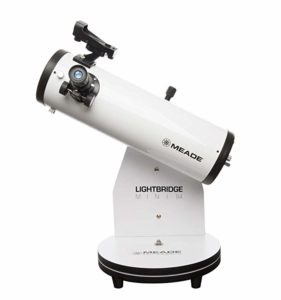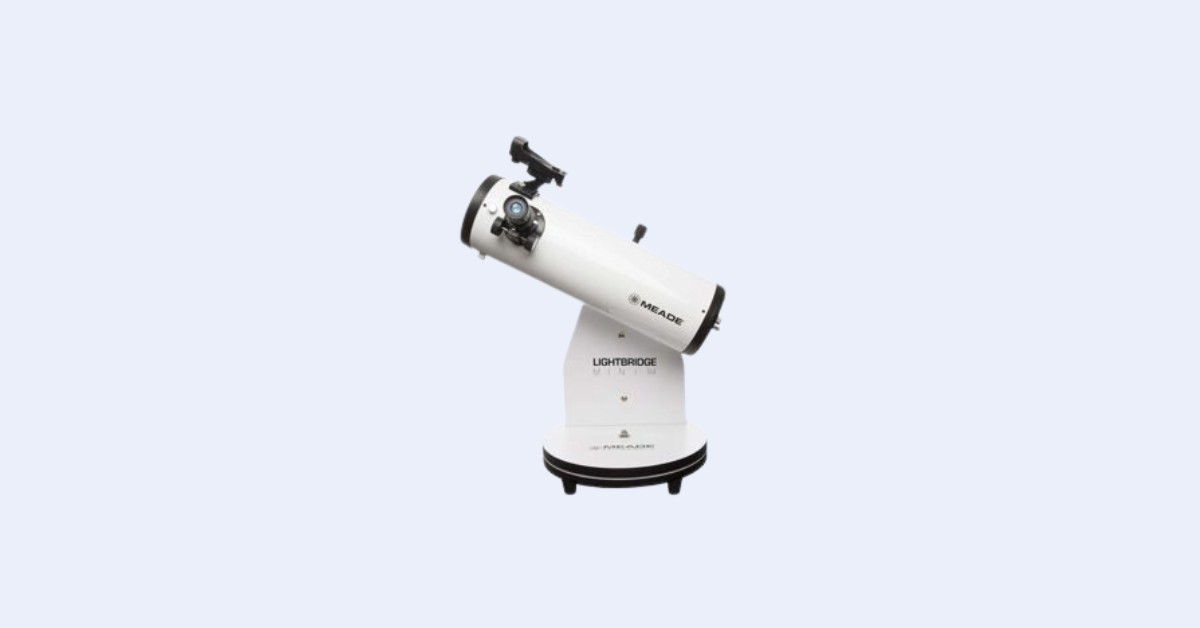Meade’s Lightbridge Minis are some of the best beginner telescopes available for under $200. Unlike many cheap instruments which include complicated and wobbly equatorial mounts, poor optics, unusable finderscopes and plastic eyepieces, the Lightbridge Mini telescopes all come with easy-to-use and stable tabletop Dobsonian mounts, decent red dot finders, and good MA eyepieces with glass optics. The 114 and 130 models have exceptional quality optics; the 82 less so.
I particularly like the Mini 114 for its overall value and features, but the 82 is a great alternative to the Celestron FirstScope and I would definitely recommend the 130 over the 114 if you can spring it.
The LightBridge Mini 82 and 114 are also sold with solar filters as EclipseView 82 and 114. Apart from the included solar filters, they are exactly the same as the regular LightBridge Mini scopes.
The Mini 82 Optical Tube
The Mini 82 seems to borrow a lot from the Celestron FirstScope and Orion FunScope. It’s an 82mm f/3.7, with a spherical primary mirror. Like the FirstScope and FunScope, it cannot be collimated, or at least not in the regular sense. I was able to get mine collimated by widening the holes attaching the tiny mirror cell to the tube and adjusting the tilt of the mirror cell assembly by just the right amount. This is tedious but works and can be done in about ten minutes.
If you can get the scope collimated you can expect to just barely see Saturn’s rings, the Moon’s craters, Jupiter’s satellites, the phases of Venus, and a few dozen easy-to-find bright deep-sky objects. The spherical primary mirror means sharp views above around 40x magnification are not possible, and even the 33x provided by the included 9mm MA eyepiece is a bit much. There is also quite a bit of a coma at low magnification.
The focuser on the Mini 82 is a plastic 1.25” rack-and-pinion design, identical to the one on the larger Lightbridge Minis.
Unlike the larger Minis the 82 is directly attached to its mount with a bolt, rather than via a Vixen dovetail plate/saddle.
The Mini 114 Optical Tube
The Mini 114 is basically a reskinned version of the Orion StarBlast and Zhumell Z114, a 4.5” f/3.9 Newtonian. The optics are collimatable and the primary mirror is a paraboloid of decent quality (unlike the Mini 82’s low-quality spherical primary).

The optics in the 114 are good enough that you can use up to about 200x with no problems – the main limitation at magnifications above 100x or so, however, is that it is a little difficult to track with the mount by hand. Additionally, good eyepieces with focal lengths below 6mm are hard to come by at an affordable price.
At low magnifications, you can expect to see some coma with the 114 due to its ultra-fast f/3.9 focal ratio. There is no real way to deal with this – coma correctors are more expensive than the entire scope and only available for 2” focusers, which none of the Minis have. However, the coma will go away at moderate and high magnifications and you may or may not notice it at low magnification anyways.
The Mini 114’s aperture is enough to show you a wealth of detail on the Moon and planets, as well as several thousand interesting deep-sky objects.
The Mini 114’s tube attaches to the mount via a Vixen-style dovetail, so you can easily install it on another mount or a photo tripod if you wish. Sliding the dovetail also allows you to balance the scope to compensate for the weight of a heavy eyepiece, should you choose to use one with the scope.
The Mini 130 Optical Tube
The Mini 130 uses optics identical to those of the various models of Celestron 130mm Newtonians, Zhumell Z130 and Astronomers Without Borders OneSky.
At the 130’s f/5 focal ratio, coma is far less of an issue than with the f/3.7 and f/3.9 Mini 82 and 114. The Mini 130 provides slightly sharper images than the 114 (thanks to its longer focal ratio, the mirror is easier to make to high specs) as well as having slightly more aperture. The extra 16mm may not sound like much, but it’s enough to start resolving some of the brighter globular star clusters if you have good enough skies, and allows the scope to provide images about 30% brighter than the Mini 114’s.
Like the Mini 114, the 130 attaches to its mount via a Vixen-style dovetail, and thus can be adjusted to balance with different eyepieces/accessories or put on different mounts/tripods.
Accessories
The Lightbridge Minis all come with the exact same accessories: 26mm and 9mm MA eyepieces providing 12x/17x/25x and 33x/50x/72x respectively, and a red dot finder. The 82 also includes a plastic 2x Barlow lens of rather low quality which I do not recommend using.
The MA eyepieces are certainly acceptable for the price, at least with the 82 and 114. With the 130, however, the amount you’re paying for the scope really should be getting you some real Plossl eyepieces.
The Meade Lightbridge Mini Tabletop Dobsonian Mount
The Lightbridge Minis use a simple alt-azimuth mount made mostly out of particle board. The dimensions are different for each model but the basic mechanics are the same. Altitude motion is provided by a simple friction-based system of felt/plastic turning on a bolt; azimuth motion is provided by the laminate surface of the azimuth board riding three small Teflon pads. While the altitude motion is not as good as the azimuth and not technically a true “Dobsonian” since it lacks Teflon or laminate, the design still works quite well.



According to Meade’s website, if it can be trusted, the LIGHTBRIDGE MINI 82 and IGHTBRIDGE MINI 130 are discontinued (https://www.meade.com/telescopes/newtonian-reflector/lightbridge-mini-82.html & https://www.meade.com/telescopes/newtonian-reflector/lightbridge-mini-130.html). The LIGHTBRIDGE MINI 114 REFLECTOR (although the site has a copy error and calls it a REFECTOR) is still in production (https://www.meade.com/telescopes/newtonian-reflector/lightbridge-mini-114.html). Additionally, the ECLIPSEVIEW™ 82MM REFLECTING TELESCOPE and the ECLIPSEVIEW™ 114 REFLECTING TELESCOPE are both in production which essentially are the LIGHTBRIDGE MINI 82 & 114 respectively with the addition of a removable white-light solar filter.
Hello Samuel,
Meade has discontinued both Lightbridge Mini and Eclipseview series. They both are available in some not-so-popular retailers, but it’s just until they too are out of stock. We had confirmed it with Meade a few weeks ago.
Thank you for the response.
Meade should update there website then, and while they’re at it, they should do a better job proofing the listings https://www.meade.com/lightbridge-mini-114.html.
Hello Samuel
Hi I bought the meade mini 114 for my partner (last year), she loves the scope but hate the stand. So i was wandering could I pair this up to a Skywatcher EQ2 mount. The problem I have is where the eye scope would end up??? should I buy those round brackets things (no idea what they are called) like I’ve seen on a celestron astromaster 114eq.
Regards Stewart
Not worthwhile.